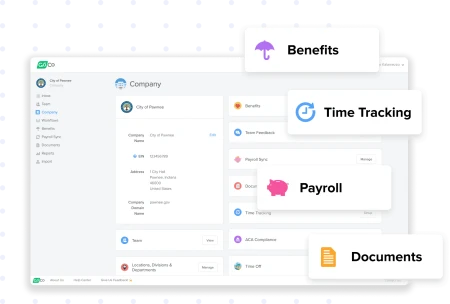How To Retain Employees In 2023: 15 Strategies For HR
15 of the best employee retention tips for 2023 and beyond
by Nick Schurk - January 9th, 2023
In 2021, as the nation began to make a comeback from the COVID-19 pandemic, HR leaders began hearing more and more about The Great Resignation. This phenomenon refers to the overwhelming spike in quit rates across the U.S. as businesses were just starting to get back on their feet.
Consider that nearly 2.7% of workers in America left their jobs in April of 2021— the highest percentage in more than 20 years. Additionally, 25-40% of workers have recently considered quitting their jobs. What’s causing elevated quit rates and employee churn post-pandemic?
Why Quit Rates are Soaring
After years of uncertainty amid the COVID-19 pandemic, many employees that have weathered the storm are reconsidering and prioritizing their career paths. While in years past, most workers valued job security in the face of an economic crisis, many employees are now re-evaluating their goals. Here are some of the key reasons this is happening now:
The pandemic allowed employees time to re-evaluate and improve their skill sets
Employees are concerned about career advancement opportunities
Workers are now looking for a job with more flexibility or the potential to work remotely long-term
Less experienced, lower-skilled workers and customer support positions are leaving low-paying jobs for positions with better compensation.
Businesses and HR pros are now wondering how to retain employees, continue to make them feel valued, and stay competitive in the current job market. Keeping employees motivated and engaged is an essential part of any successful business. In 2023, there are some exciting strategies being implemented by companies around the world to keep their workforce motivated and engaged. Let’s take a look at some of the strategies being used.
What Is Employee Engagement?
First, let's define what we're talking about: Employee engagement refers to activities or programs designed to increase job satisfaction, enthusiasm, commitment, and loyalty among employees. By keeping employees motivated and engaged, businesses can reap many benefits such as increased productivity and improved customer service.
Strategies to Keep Staff Motivated and Engaged In 2023
Many companies are implementing unique strategies in order to keep their staff motivated and engaged in 2023. Let's take a look at a few of the major trends.
Make Work-Life Balance a Non-Negotiable
One of the best and easiest ways to improve employee retention is to make balance a non-negotiable. In a recent Indeed survey, over 50% of respondents are experiencing burnout this year. With remote work blurring the line between work life and home life, HR plays a key role in setting the expectation.
Gergo Vari, CEO and founder at Lensa, suggests, “Offering our people flexible work hours and remote work options has helped us keep employees happy and reduce turnover over the last year. Employees appreciate being able to have a say in when and where they work, and this perk can be a big selling point when it comes to attracting and retaining top talent.
“When we first started the remote work shift, we found that managers were trying to micromanage employees’ work-life balance, and it was backfiring and creating more stress for everyone involved. Instead of telling employees how they should spend their time outside of work, businesses should trust that their employees will use their time wisely."
“It is simply an instance of hustling culture when people become solely focused on their career aspirations and neglect their personal lives,” says Eric Jones, CEO of Couture Candy “Make sure your organization and company aren’t involved; otherwise, it can stifle a company’s originality or productivity, and its aims and accomplishments will be confined to doing chores.”
Create an Employee Bonus Plan
A bonus can be any form of direct compensation that falls outside of the predetermined salary or pay rate – typically given as a form of reward or incentive based on performance. A bonus plan, more broadly, is a structured form of distributing bonuses to employees and outlines things like eligibility, criteria, amount, and frequency.
Common types of bonus plans include:
Annual or Quarterly Bonuses
Typically given as a result of meeting performance targets, this type of bonus plan depends on the organizational performance cycle. In seasonal sales roles, for example, quarterly incentives may make the most sense. In sectors where results take longer, annual may work better.
Spot or Ad-hoc Bonuses
Typically given on the spot for performance reasons or as a general incentive or show of gratitude. These bonuses are typically much smaller in amount, but this usually depends on the organization and the frequency of the bonuses. For some, it may be a $25 gift card while for others, it may be $1,000.
Referral Bonuses
Given to an employee as the result of successfully hiring a candidate they referred. Organizations can consider using these for roles that are unique or otherwise difficult-to-fill, or roles that are aligned with organizational goals, such as diversity. It’s common for the bonus to be given after the new hire completes their probationary period at the organization.
Hiring or Signing Bonuses
These are extremely common in some industries like IT or consulting. They are a great way to entice a highly desirable candidate to move to a new city or state or take your role over another offer. They are sometimes distributed in a staggered way to avoid a job-hopping scenario. Other times, they will include a percentage-based repayment clause if the employee leaves the organization in under a year.
Profit-Sharing Bonuses
This type of bonus allows employees to receive a percentage of company profits if the organization has a better-than-average year, which in turn, can motivate them throughout the year in terms of productivity and performance. The approach typically involves either a cash bonus or a direct contribution to the employee’s 401(k) but also comes with regulatory requirements. Organizations considering this bonus type should talk to their accountants or financial advisors.
To keep up with current trends in the market, businesses should evaluate their employee motivation plans on an ongoing basis so they can adjust them accordingly if needed.
Different types of rewards work better for different employees; so offering tailored bonus rewards based on individual performance or needs can help ensure that everyone feels valued within the organization.
Incentivize With Growth Opportunities
"I feel that the simplest way to avoid hiring problems is to focus on maintaining current staff," says Martin Lassen, Founder & CEO of GrammarHow. "Due to the rise in competition, a number of businesses are offering financial and educational incentives to attract candidates."
Ensure that your company is an interesting and desirable place to work by providing possibilities for professional growth, providing high-performing employees with stretch jobs to progress into, and listening to your staff regarding remote work and office hours. It has been demonstrated that both lateral and upward internal mobility increase employee retention. If they believe they cannot find a better opportunity elsewhere, employees will be more likely to remain with your organization.
Invest in Ongoing Training Resources
Though most employers offer employees the proper training during the onboarding process, a large majority do not continue to offer resources to keep their abilities up to date. Employees don’t always have extra time for training, and their lunch or break time is just that – their time!
Make time for training classes during work hours, but don’t expect employees to attend a 4-hour class and then return to their regular tasks. Take a cue from YouTube and TikTok: short, incremental classes of 30 minutes or less are incredibly successful, and they allow employees to fit them into their calendars without creating a backlog of work to be caught up on.
"Employees cite the highest rates of dissatisfaction when they feel they've 'maxed out' their learning and development potential," says Max Wesman, Chief Operating Officer at GoodHire, "A lack of growth can cannibalize morale, leading to rapid burnout and attrition among employees. The lesson is clear: if your team can't find growth opportunities within your company, they won't hesitate to further their search elsewhere."
Hire Selectively from the Start
Every company strives to retain employees after they're onboarded, but they often don't realize selective hiring practices can make all the difference. Team leaders may be impatient to get new staff on board quickly, but it's worth recruiting intentionally to find the right fit. Consider that hiring a bad fit who leaves within the first year can cost 33-200% of their annual salary!
Hiring with precision supports company culture, and carrying out a thorough interview process ensures a new employee has a better chance of succeeding at their role. This leads to less attrition and lower training costs while empowering employees to do great work long-term.
Offer Competitive Salaries and Benefits
You've probably noticed that to retain workers at any level in 2023, you have to pay them more right out of the gate.
"This is always a key factor in attracting and retaining top talent," says Linda Shaffer, Chief People Operations Officer at Checkr "Now that many companies are offering more competitive salaries and benefits, it's even more important to make sure your company stands out in this area!"
Offering a competitive salary and benefits package demonstrates to your team how much you value their hard work and contributions making them more likely to stay with your company for the long run.
Make sure that what you offer is not only competitive, but also tailored to attract the type of employee you want and retain.
Foster a Culture of Rewards & Recognition
"As the saying goes, 'People don't leave companies, they leave managers.'" Says Travis Lindemoen, Managing Director at nexus IT group. "It's important to focus on creating a positive work environment and fostering recognition for a job well done. A simple thank you can make your employees feel so appreciated!"
"One of the greatest facilitators of professional motivation is recognition," says Ricardo von Groll of Talentify. "Don't wait to learn how to congratulate your employees on their success and for doing well. Feedback can make all the difference for an employee. Recognition can come as benefits, such as courses paid by the company, salary bonuses, or even a simple thank you from the company for major achievements."
Creating this culture while working remotely is an important component of employee engagement and long-term interest in their jobs. Upper management should regularly interact with team members and show gratitude, especially remote employees
“Recently, we have mailed gift packages to our remote team as a token of our appreciation, says Jonathan Zacharias, Founder of GR0. “We understand that there are lots of opportunities on the job market today, so a bonus, in addition to fair compensation, goes a long way.”
Ramp Up Mental Health & Wellness Benefits
During the pandemic, 4 in 10 adults in the United States have reported symptoms of anxiety or depression, which is significantly higher than the year before. Employees are counting on HR and employers to help support healthy mental health practices.
“In addition to our previous sick leave package, we offer a set number of mental health days to each full-time employee," says Ravi Parikh, CEO of RoverPass. "This prevents burnout by giving employees a way to take time off when they are struggling with anxiety, depression, and other difficulties with their mental health.”
“This goes beyond simply providing a hybrid remote work environment and unlimited PTO,” advises Andreas Velling, Chief Marketing Officer at Fractory “You should check in with your team on a regular basis to assess their workload and overall happiness at the company. Scheduling check-in team meetings that have nothing to do with work is another tactic I’ve found effective in developing a great company culture.”
Offer Work From Home Options or Flexible Schedules
With many businesses going remote since 2020, many employees will not want to go back in the future at all. If your business is able to run on a remote or hybrid plan, consider making the switch.
“We found that eighty-four percent of employees say that not having to travel to their place of work is the most important benefit of working remotely, says Graham Beck, Co-Founder & CEO of DropDesk. "Employees have embraced remote work so much that in the U.S. alone, 39% of adults surveyed said they would consider quitting if it was taken off the table. That figure goes up to 49% if you talk to millennials and Gen Z employees."
Modernize Your HR Software
Having the ability to digitally access onboarding documents, benefits plans, and pay stubs is equally important for HR professionals and employees. On one hand, with a modern HRIS, HR managers are able to streamline previously paper-based processes and checklists with the click of a button. On the other hand, employees feel empowered with the ability to check pay stubs, request PTO, and update personal information without having to go through another party.
Upgrading to an HR software that offers onboarding, payroll, and time-tracking in a single log-in improves the employee experience exponentially, which in turn sets them up for success in the organization.
Establish a Mentorship Program
Once your employees are fully onboarded, how often do they meet with mentors (who aren’t their supervisors) for guidance? For many employers, onboarding doesn’t extend past the first week of employment.
“Employees benefit from mentorship because they believe they are valued and supported," says Matt Weidle, Business Development Manager at Buyer’s Guide. "It’s a key component of employee retention. Having a mentor from day one, someone they can go to who isn’t their supervisor and ask questions about the job, makes the individual feel more connected and less scared by the prospect of a new career with new chores and responsibilities.”
Use Tools to Gauge Employee Engagement Levels
Employers can boost retention by taking the pulse and getting an accurate reading of employees’ engagement levels via tools like Officevibe. These tools keep HR professionals in the loop about how employees feel across the board and can flag potential retention issues so that HR professionals can react in time.
Always Conduct an Exit Interview
Just as onboarding is crucial to the longevity of an employee’s career within an organization, so is offboarding. Exit interviews for quitting employees give HR a good grasp of what may need to change within the business, and how to prevent the same mistakes from happening over and over again.
When valued employees leave your business, the best course of action is to ask them why. Gather data on why they chose to leave the company, and from there, and formulate a plan on how to prevent this from occurring again.
Be Transparent About Business Stability
Being honest and transparent with your team members about business stability reminds them of their importance in the success of the organization. HR managers and leadership should take extra steps to keep employees informed on business plans.
“Communicate to employees about business plans, future prospects, and business continuity and success metrics," says Gargi Rajan, Head of HR at Mercer | Mettl. "Organizations need to ensure employees feel supported during crises and don’t have to worry or be overwhelmed with their job security and financial stability. When employees are confident in organizational offerings and can put their trust in organizations taking care of not just the employee, but also their families, the employee churn rate is reduced.”
Focus on Situational Leadership
"Employees are seeing a clear disconnect between what their employers are promising and what they are delivering," says Jessica Miller-Merrell, founder and CIO of Workology. "If a manager really wants to make a difference and salvage their team from jumping ship or mentally checking out, they learn to employ situational leadership strategies to better connect, engage, and motivate their workforce."
Situational leadership involves using the correct leadership style based on the current situation. Traditionally, there are four types of situational leadership that require varying levels of directive or supportive behavior. Managers can use a combination of techniques depending on the individual employee taking into consideration the best factors to individually motivate and connect with said employee.
Final Thoughts
Whether or not your business is directly feeling the continued impact of the Great Resignation, it’s crucial as an HR professional to continuously reflect on your employee retention strategies for a brighter future at your company. Ultimately it’s important to remember that investing time and resources into keeping your employees engaged will pay dividends down the road!
One of the key ways to better manage and keep employees in the loop is to adopt modern HR technology. If you’re ready to explore your HRIS options, take a free interactive tour of GoCo to see how we can help!

Subscribe to Beyond The Desk to get insights, important dates, and a healthy dose of HR fun straight to your inbox.
Subscribe hereRecommended Posts
22 Employee Engagement Ideas That Remote Workers Love
Blog Articles
21 Statistics on Working From Home & Remote Work in 2023
Blog Articles
77 Critical HR Statistics For 2023
Blog Articles
Search...
Product
GoCo
Resources
Articles
eBooks
Webinars
Customer Stories




